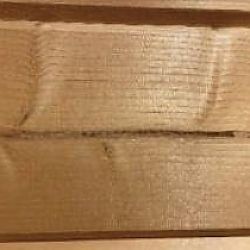- Naturally and responsibly grown raw material
- Eco-friendly
- Water-saving (when compared to brick-and-mortar houses)
- Unique designs
- Good stability
- Relatively light (when compared to stone or iron)
- Easy to modify
- Versatile
Natural characteristics of timber
Timber is a wonderfully natural product, with it’s own characteristics and uniqueness. Embrace the fact that your cabin will be different to everyone else’s. Even though the timber in your cabin isn’t still growing in the ground, it will still want to do what it is naturally created to do.
|
Cracks
|
Cracks may seem alarming when you first notice them, but are just a sign that the timber is naturally drying out. Timber wants to match the humidity in the air around it, it is trying to reach an equilibrium. The inside of a log will take much longer to dry out than the outside, as this happens, a crack appears in the timber due to the pressure which has built up inside. This does not effect the structural integrity of the timber, and the crack will start to close over as the whole log reaches it’s equilibrium. This timber is not faulty, it’s just doing what it is meant to do. These cracks can be minimised with the use of adequate treatment, as the timber will not be able to absorb as much moisture. |
||
|
Doors/Windows
|
Doors and windows are made up of finger joints, which can be made from different grains, hence their appearance can differ. This does not affect the quality or strength of the parts. |
|
|
|
Knots
|
Knots are a natural characteristic of the timber, some logs have lots some have none, some are small, some are large. Knots can be sealed or a knot inhibitor used before painting, if you want to cover them over. |
||
|
Blue Stain
|
Blue stain can show on the timber in your cabin as blue, grey and even black marks. This is a harmless microscopic organism which was present in the tree when it was growing, it then shows itself if the moisture level in the timber increases. It does not effect the structural integrity of the timber and is not mould. It’s appearance can be reduced by using a primer for blue stain. |
||
|
Expansion and Contraction
|
Over the changing seasons and weather conditions, the timber in your cabin will expand and contract, this is perfectly natural, the design and build of your cabin has been done to allow for that. However we do not want this to be excessive, therefore it should be kept to a minimum by adequately treating your cabin. This means adequately covering all areas of the timber so no moisture can get in at all, including – the underside of doors and windows, in between each log, right in at the corner joints, the end grains and right up to where the timber meets the glass on doors and windows. The cover of treatment should be uniform and there should be no patches. If in doubt add another coat. Untreated timber will expand and contract more than treated timber. |
||
|
Resin
|
Resin leaks especially in spruce cannot be prevented, in particular when there is a change in humidity or temperature, and more often in the first year. If this happens the resin will dry out to a crust which can be easily removed. |
||
|
Pith
|
Pith is formed at the very centre of a tree and is part of the original stem when the tree started to grow. It is a natural part of the timber and is not caused by damage to the timber. |
||
|
Knot staining
|
A yellowish or brownish mark (caused by timber acid) which can show through white/light coloured paint, this cannot be fully prevented, but can be minimised with the use of Knot Inhibitor. |
|
THESE CHARACTERISTICS DO NOT CONSTITUTE A REASON FOR A WARRANTY REFUND.







